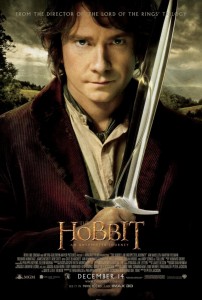
Seriously? Part 1 of 3?
[Update: Part 2 of this analysis, “The Desolation of Statistics,” is now available!]
I know I’m late to this party, but I finally got around to seeing The Hobbit: An Unexpected Journey after hearing much belly-aching over how the story of a single book is split into three separate movies: it seems like a blatant cash grab by the studios, a cynical move that put franchise movie economics ahead of things like storytelling and pacing.
After seeing the movie, I can definitely sympathize with these complaints. It felt slow at times, particularly during the multiple expository scenes in the first half and the interminably long action sequence in the second half. Most importantly, I felt like the story didn’t advance far enough to justify taking up an entire movie on its own, especially compared to the Lord of the Rings movies.
So me being me, I decided to put this issue into quantitative terms. Specifically, I wanted to compare the length of the Hobbit movie to that of the source text, and run the same analysis for the three Lord of the Rings movies.
For movie length, I simply used the run time for the theatrical version of the movie as listed on IMDB. For book length, I chose to go with word count rather than page count, since there’s so much variability when it comes to the number of words that get squeezed onto a single book page.
Before I hit you with the graphs, I should mention the obvious caveat, which is that a long word count of a book does not necessarily translate to more story elements that need to be crammed into a movie. Also, it’s been a while since I’ve read the various works of J.R.R. Tolkein, so I can’t speak authoritatively to the density (or lack thereof) of plot in those books.
All this is to say that word count is an imperfect proxy for the amount of plot-related content in a book that might need to get translated to a movie.
OK, enough caveats. Let’s see the numbers, or more specifically, my key metric for comparing movies: the number of word in the book divided by the number of seconds in the movie. In other words, words per second of movie. The idea is that a movie like The Hobbit: An Unexpected Journey will have a small number of words per second of movie, since it’s only adapting part of a short book into a rather long movie.
ENOUGH WORDS! SHOW ME GRAPHS!
*To simplify things, I divided the total word count for The Hobbit (95, 022)by three and used that count for each of the three Hobbit movies (31,674)
**Because run times for the next two Hobbit movies are unknown, I reused the run time for the first Hobbit movie (169 minutes, or 10,140 seconds) for the next two installments.
So what does this graph tell us? That, in a strictly quantitative sense, the three Hobbit movies are laughably lacking in density of source material presented on screen compared to the three Lord of the Rings movies. This really shouldn’t be surprising, given that the rest of the internet was able to intuit this on their own and complain about it without the use of a graph like this. But I wanted to go through this exercise as a way to lay the groundwork for a broader consideration of how books get adapted to movies, and the extent to which studios inappropriately stretch out a single book into multiple movies.
Let’s apply this same methodology to one of the most commercially successful movie franchise adapted from a book franchise: Harry Potter. Like The Hobbit, it too has a single book that was split into more than one movie (Harry Potter and the Deathly Hallows):
A few interesting things of note: the average Words in Book per Second of Movie (WIBPSOM) for the Harry Potter movies is 15.45, which is actually higher than that of the Lord of the Rings movies (excluding the Hobbit movies), which comes in at 13.7. This is largely driven by the hefty tomes in the middle of the series that got their own movies: Goblet of Fire (157 minutes, 190,858 words), Order of the Phoenix (138 minutes, 257,154 words), and Half-Blood Prince (153 minutes, 169,441 words). But note that even though Deathly Hallows (198,227 pages) got split into two movies, the WIBPSOM for those two movies is still way, way higher than that of the Hobbit movies, and actually comes close to that of the Lord of the Rings movies.
(Caveat: I have not read any of the Harry Potter books, but that’s actually not relevant to this exercise. Remember, we’re using word count as an imperfect proxy for plot material in a book. That being said, feel free to talk about all the amazing stuff in Order of the Phoenix that they had to cut out of the movie in the comments. More relevant caveat: for Deathly Hallows, I just split the word count in half and used that number for both movie installments.)
It seems like the Harry Potter franchise densely packs book material into its movies, but what about yet another movie franchise that’s based on books, and also has a book that’s split into multiple movies? I am of course, referring to the Twilight Saga:
More so than with the Harry Potter series, we see a consistently high WIBPSOM across all entries in the Twilight Saga (yes, I insist on referring to it as a saga), including in the split installment of Breaking Dawn. And it goes without saying that these numbers are way higher than the pathetic 3.12 WIBPSOM for the Hobbit movies.
I could easily stop here and declare victory over the Hobbit, but I’m not done yet. We have YET ANOTHER book/movie franchise with a split installment to analyze: The Hunger Games.
Because the remaining three Hunger Games movies have yet to come out, I simply used the run time of the first installment (142 minutes) to calculate the WIBPSOM values for those future movies. This may not be the case, particularly with the two Mockingjay movies, but even if they come in at a more standard 120 minutes apiece, that would bring their WIBPSOM values up to only 6.96, from 5.88. Which is still much higher than that of the Hobbit movies. In other words, the studio may be “Hobbiting” Mockingjay by splitting a relatively short book into multiple installments, but they’re not doing it as badly as they are with the Hobbit.
But I say “badly” like “Hobbiting” a book is automatically a Bad Thing and that we should be able to optimize movie adaptations of novels through math. That would be quite the stretch. We can say definitively that The Hobbit is stretching its content (or at least its words) among movies to a degree that none of these other franchises have done so (or are planning on doing), and I would argue that The Hobbit: An Unexpected Journey suffers as a result of this stretching. But we can’t say definitively that The Hobbit would be better served as just a single movie, since we’re not able to see that movie. And again, in case I wasn’t clear enough: word counts are proxies for content that would need to be adapted into a movie, not direct measures of that content.
All that being said, I still think this is an interesting way to examine these book-based franchises and how they adapt source material for different media and business needs. If you agree, let me know in the comments! I have more data for other books/movies, and could easily expand that data set. And I know you all like graphs.
[Continued in Part 2, “The Desolation of Statistics.”]
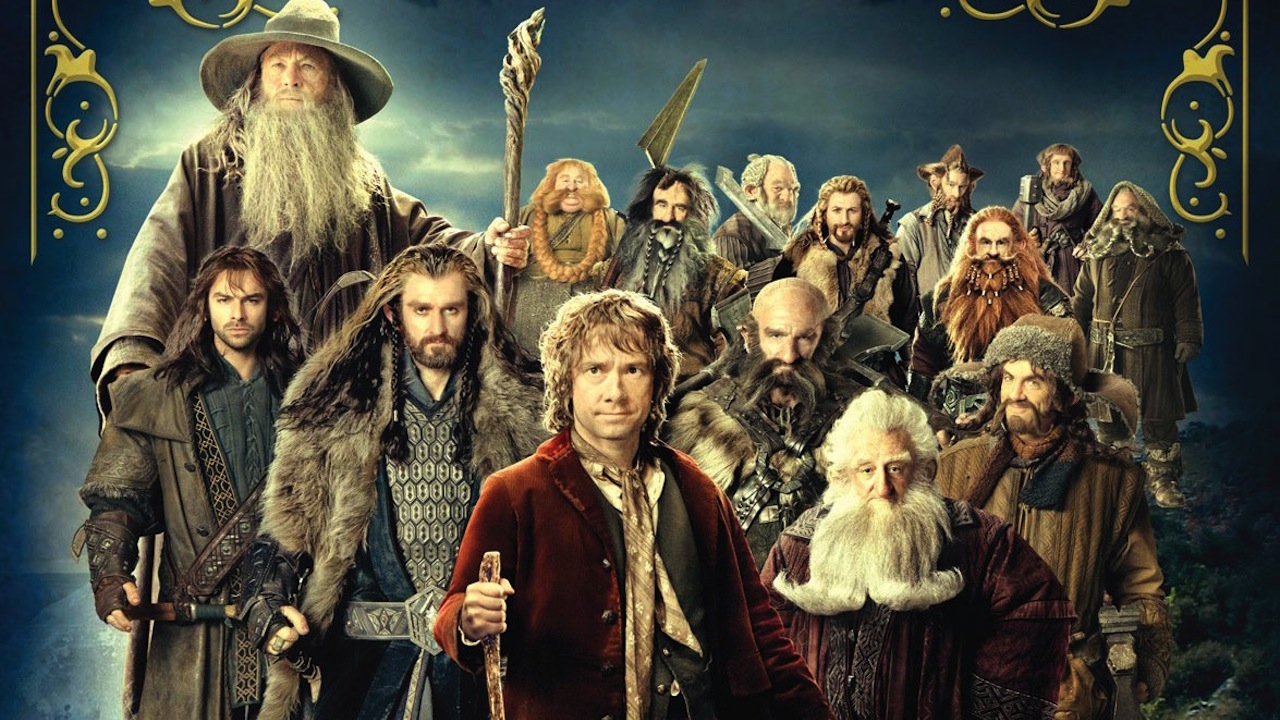
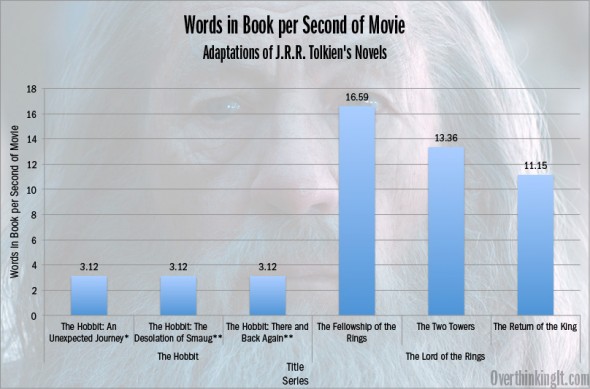
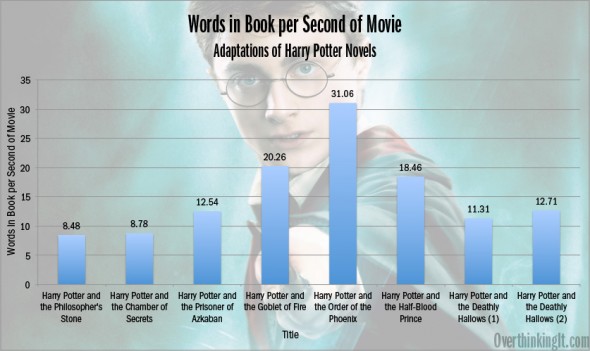
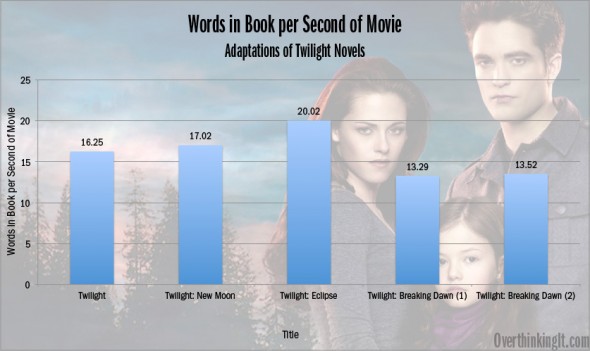
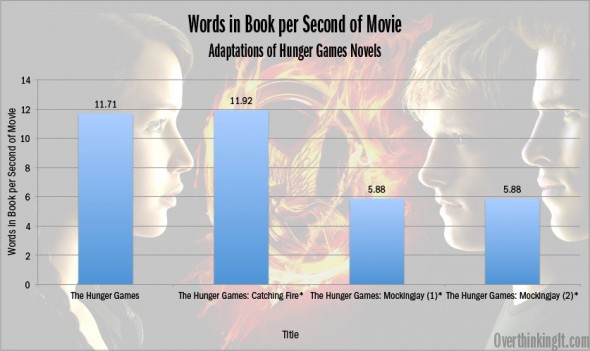
A flaw in your system is that The Hobbit integrates material that is not presented in the book into the film in order to provide additional continuity. Some of that material appears in The Silmarillion, so an argument could be made that the word count of that book, if included, would affect the ratio for the films.
Thanks for pointing this out. Expect a part 2 post next week that will investigate this.
It is different when a movie incorporates material from multiple books. The first example that comes to mind is Master and Commander: The Far Side of the world, which combines material from two different books in the series for the plot of the film.
I’m wrapping up Part 2 now and wasn’t able to cover this matter–didn’t feel comfortable enough to do so without having more familiarity with all of these texts being tossed around. But there are some interesting findings (and non-findings) nonetheless! Stay tuned…
“A flaw in your system is that The Hobbit integrates material that is not presented in the book…”
That’s a little like pointing out that, in all fairness, these sausages are 70% bread, you can’t expect them to taste of pork.
Personally, I don’t feel the issue with the films is even that they’re three films, but that they’re three films of three hours long. Three 90-minute installments would push the WIBPSOM up to 5.86, around the Mockingjay/GOT S3+4 level.
Also, judging from this article I suspect that around 5 or 6 is the threshold for Hobbiting.
I don’t think I agree with your analogy.
I’m a great fan of Tolkein’s writing and certainly think Peter Jackson swung & missed on a number of counts in The Hobbit’s first installment. But I can appreciate something he was trying to do, which is weave a lot of “various forces at work in the world of Middle Earth behind the scenes” into the movie to try and give it an overarching narrative, aside from “a series of generally unconnected vignettes,” which is kind of what the book is.
As an example:We KNOW from the book (and what we learn later in Lord of the Rings) that Sauron has returned to the world and has turned Dol Goldur into his new stronghold and that’s why evil has returned to Mirkwood. We also know that the finding of the ring would be of great interest to a great many actors in this world. But neither of these two facts really factor into advancing the plot, in the books. Peter Jackson chose to explore a few “what if…” questions.
It may *still* amount to a shameless, cynical, money-grubbing box office stunt. And it may have still resulted in some dry filmmaking. But I think it was not an altogether value-less artistic exploration. AND I agree with Jamie, above, that the movie feels like it needs to be evaluated on different terms as a result.
Technically the other material comes from the Appendices of the Lord of the Rings. It cannot legally come from the Silmarillion since the filmmakers do not have the rights to use material from the Silmarillion.
There is *some* dubious and sly reference to some minor works contained in ‘unfinished tales’ but is mostly connected to an excised chapter of Lord of the Rings titled “The Quest for Erebor”. However even if you counted the words on these pages.. you’re talking about maybe 5-10 pages of additional material.. the vast bulk of the material on screen in the Hobbit is coming straight out of the word processors of Walsh, Boyen, and Jackson.
The above comment is incorrect, but might be on the right track. PJ is not allowed by law to use any Silmarillion material. The film rights to it simply have not been sold. But what is relevant is that material from the LotR Appendices has been used. So the question is did Mr Lee include those in his word count or not?
To correct your statement somewhat, NONE of the material used by Jackson is featured in The Silmarillion because they have no legal right to use anything from it. The Tolkien Estate still owns all rights to The Silmarillion and would sue Jackson/ New Line if they felt their was the slightest infringement on their material.
The additional content is from the Appendices that came with Return of the King: having said that 90% of what Jackson did was too take some names and general details from the appendices then COMPLETELY change them in the film, to the point where they may as well be counted as original content.
The best example of this if the entire Azog storyline, has no basis in Tolkien (the only thing the stories share is that there was a battle outside Moria between the Dwarves and Orcs…Jackson changed all the details that Tolkien wrote.)
The White Council scenario, so far, is also playing out in a different manner to how Tolkien wrote (and from the sounds of the Dol Goldur section will diverge even further.)
And in anycase if you were to take all the material Tolkien wrote about the Dwarves and White Council etc that Jackson has access to it would add up to, at best, 10-20 pages (which divided amongst three films would adjust the calculations by the tiniest of fractions.)
I have a feeling that this should be generalized to all novels adapted for the screen. Perhaps a graph with “Movie Length in Minutes” on the horizontal axis, and “Book Length in Words” on the vertical. Your sample size is probably a bit too small for any real analysis.
For novels split into multiple movies, I’d use the combined movie length. It doesn’t seem valid to divide the novel arbitrarily in half, on the assumption that the movies break right at the midpoint of the novel.
This is a great idea and very well executed. I am wondering, however, if there isn’t a good reason behind The Hobbit being an outlier, other than the often-assumed greediness: If I understood it correctly, the idea was to build the background to the LOTR movies by combining The Hobbit with The Silmarillion and Unfinished Tales. Since the rights to the latter two works were not secured, production was limited to what is mentioned in The Hobbit — leading, for example, to the absurd situation that Azog, the main antagonist of the movie, is only mentioned once in the book.
As a consequence, you could count the word counts of the other two works into your analysis, which would certainly shift the numbers around. In any case, I propose that the background/production of The Hobbit was sufficiently different to exclude it as a viable point of comparison to the other movies named here.
Oh man, Jamie’s comment was not up yet when I started typing mine. This is what you get from commenting and working simultaneously :(
If I had the time and energy and tools, I’d take all three final Hobbit movies and see if I couldn’t cut them into one that was a more standard running time. ‘Cause there really was a lot of fluff.
I was surprised by the Harry Potter results, but I guess I’d forgotten that the size of the books kind of follows that arc, as well.
If you want to crunch more numbers, it might be interesting to see if there is a numerically-significant WIBPSOM for movies adapted from books that have won awards for best adaptation or the like. Just because it’d be funny. :D
Could this be the secret reason all film adaptations of The Great Gatsby kinda sorta suck? Baz Luhrman’s recent film scores 5.49 WIBPSOM. Slightly more than The Hobbit, but still lower than any other film adaptation you mentioned.
I still don’t understand why they split up Mockingjay (other than a cash grab). Did it have any more plot than the first Hunger Games?
I would have actually split Catching Fire, if I wanted to follow the books’ structure, since the middle volume is roughly half “dealing with the consequences of Katniss & Peeta’s actions, the emotional damage of the Games, and their supposedly pending wedding” and roughly half “MORE Hunger Games” (ie the Quarter Quell). But I am assuming this wasn’t done because the first half doesn’t have enough violence, because of course, the people making and watching the movies are the very folks the people of the Capitol are meant to satirize.
Good Post Mark! – NY
I love this post!! Partly because, however imperfect, it totally supports my point of view that splitting Breaking Dawn and Deathly Hallows was justifiable and splitting The Hobbit are just not. It’s easy to like things that agree with me.
I’ve also read a few of the comments that mention Jackson’s use of The Silmarillion and your part 2. Be sure to take into account that in addition to adapting material from additional works, Jackson also embellished a lot of that adaptation and it’s more his work than Tolkien’s and it sucks. I don’t know how you quantify the quality – but it’s glaringly obvious in The Hobbit what Tolkien wrote and what Jackson wrote.
If (as Jens Yenzo stated) rights to the Silmarillion had not been secured, it may have been necessary for Jackson to significantly change any Silmarillion-inspired content to avoid copyright violation. (Of course, one could still make the argument that he just shouldn’t have used that content under those circumstances.)
You’re right – there’s the copyright issue. I don’t think I’d mind so much if he hadn’t done it so badly. The dialog they (Jackson, Fran Walsh and Phillipa Boyens) cooked up is just so trite and the characters have no depth – they’re just ridiculous in the middle of a somewhat serious, very well written story. Even though they’re “technically” in the Silmarillion they’re just a line or a name and what Jackson/Walsh/Boyens created from that is just so poorly done.
You’re getting the facts confused slightly here, none of the material they used had any relation to the Silmarillion, it was all from the Appendices attached to the back of ROTK (which they do own the rights too.) If you actually read the Silmarillion 99% has no relevance to anything that would be brought up in the Hobbit, and the 1% that is was already covered in LOTR or the Appendices.
So there really was no legal reason for Jackson to change the material as much as he did, that was done purely because he wanted to make those VERY questionable changes to the story!
This is a fascinating analysis. I actually enjoyed The Hobbit because of the leisurely stroll through Middle Earth. Despite the outstanding and comprehensive nature of even the extended versions of the LotR films a lot of story was redacted for story-telling reasons. (Tom Bombadil and the Scouring of the Shire are two obvious examples) It might be worth pointing out that there was an animated film from 1977 called The Hobbit. The Hobbit ran 77 minutes, a swift but enjoyable turn through Middle Earth. I think that it took Peter Jackson told in 169 minutes what was told in ~25 in the animated flick. The animated film clocks in at 20.57 words per second.
As one of the above posters suggested, a graph of movie and book length might be interesting. Even more so of a third dimension on the graph was added for movie rating (Rotten Tomatoes for example).
How do Shakespeare fliks clock in? Olivier’s Wuthering Heights (which tells half the story)? To Kill a Mockingbird?
A lot can be done with this! This is the tip of the iceberg.
Best
Dr. J.
Logging in from work, so I can’t look up data right now, but in terms of word count, Shakespeare’s plays tend to run pretty short. That said, they’re plays, not novels, so you’re not going to get 6 paragraphs describing how the sunlight reflects off the beautiful lake in the field, etc.
I agree with you that Shakespeare plays are short, but they make an interesting control, especially as one can look to correlate word/minute to movie rating within a genre with a legion of film adaptations of the same work. Furthermore despite their short nature, the Overthinkers are certainly bright enough to find away to normalize their data.
I’m looking forward to this study applied to the Ender’s Game movie, and (hopefully) its sequels. Will Xenocide Part 1 be 120 minutes of a girl tracing wood grains? Will this still clock in at 35 WIBPSOM? Dramatic tension!
One of my favorite movies is Shawshank Redemption, which was adapted from Stephen King’s novella Rita Hayworth and the Shawshank Redemption. Word count is 38,000 words and running time is 142 minutes–this results in 4.46 words/second. Fairly low compared to most examples here (though still higher than the Hobbit), but an excellent movie.
I haven’t read Tolkien in a long time, but I remember a significant portion (say, the last 20-25%?) of The Return of the King’s page count consisting of non-plot-related “Appendices.” Taking that into account (by removing that percentage from the book’s word length) might drive up the words-per-second of the RotK movie.
I’d love to see an analysis of HBO’s Game of Thrones, but from the third season onward the progress of various plotlines in the TV series no longer corresponds to positions in the books in any simple way.
You’ve reminded me of another caveat to these word counts: they’re all sourced from AR BookFinder, which doesn’t give any indication as to where word counts are sourced from, or what is counted in word count (appendices, etc.). If anybody has any insights on this, or another source for these numbers, I’d love to know about them.
Using an e-book version counted using Microsoft Word, ROTK has 136,275 words of story, and the appendices are 50,426 words long. That’s probably pretty close, although I don’t know how the program counts words in family trees, or tables of Tengwar characters. Compare your word totals with the 186,701 I get for the entire volume.
I agree…Game of Thrones would be a great analysis of words-to-time. You could do it book-by-book, or chapter-by-chapter since phatwalda has noted that the storylines fray a bit comparing the series with the book. But still, there are well-defined chunks that directly correspond to film that can be compiled. And the fangroups out there may have already done some of the work for you.
Although I like this article and your graphs are nice,
I don’t think this hold any merit.
Both books and movies can take something small and turn it into a long drawn out scene. The things that are long and drawn out are going to differ, and in some cases be the same. It’s really just about what the director / author wanted to emphasize.
Personally, I love long movies, books and songs. I think that the Hobbit movies could have been even longer, they could have spent more time showing us fancy 3D animations and focusing on individual characters instead of group shots. So even though I like your w/B/s/M analysis, it’s kinda shallow. ¯\(°_o)/¯
Sorry, I wanted to also mention WHY I like long movies, book, songs, ect(video games).
I’m one of those people that sees these entertainment mediums as an escape from reality, but I still like for them to be grounded in realistic terms. Err, let me clarify. If I’m reading or watching Harry Potter, I want it to reflect what it would really be like to be Harry Potter. I tend to not like it when cuts and jumps happen. So I really love 24, I think when I watch a really long movie, its closer in length to the “real thing”. I don’t know, its just one of those things that only a few people would get, like when people go on a journey for months, and it takes 2 hours to tell the story, I’m left disappointed.
For those of you commenting that The Hobbit movies are using multiple sources, you are correct! However, they cannot (and are not) using the Silmarillion and/or Unfinished Tales. The Tolkien Estate has never sold the rights to those works, so the movie studio cannot legally use that content. The movie does draw on the appendices located in the Return of the King novel, which detail various components of the build up to the Lord of the Rings (among other things), with varying degrees of accuracy (the Azog storyline in particular). So, again, The Hobbit movies are using additional material, just not the Silmarillion and/or Unfinished Tales. Just wanted to clear that up!
Estel, it was my understanding that they are allowed to use content from other tolkien works, but that the estate were not allowing them to turn those books into their own movies. I thought I originally read that the series was planned to be done in 2 movies using only the hobbit until they realised this would be their last chance to squeeze in content from the other books as the estate would not allow them to make any new series using those books if that makes sense.
nameless –
Check out this article from theonering.net.
http://www.theonering.net/torwp/2013/01/07/68174-concerning-christopher-an-essay-on-tolkiens-sons-decision-to-not-allow-further-cinematic-licensing-of-his-work/#more-68174
A great article detailing how the movies will be less detailed then they could be and also why Christopher Tolkien (J.R.R.’s son and head of the Tolkien estate) will not license further material. Unless this position changes, or the next literary executor allows it, we won’t see “The Silmarillion”, “Unfinished Tales”, “The Children of Hurin” or any other Tolkien written work.
I wonder where the sweet spot is for WIBPSOM; presumably there is an upper limit as well, beyond which you are simply cutting too much important content. I remember a podcast where one of the overthinkers posited that short stories make for better adaptations, generally speaking, because you are adding detail rather than subtracting it.
I would like to see how this applies to Game of Thrones, which I think is the best job of book adaptation I have ever seen in the way it successfully picks out the important content and efficiently conveys enormous depths of information which a less skillful crew would have simply cut. I doesn’t have an exact 1:1 correspondence between seasons and books, but the 3rd and 4th seasons are (roughly) the split story of the 3rd book.
Might as well have said, “I don’t know squat about the next two Hobbit movies, so I speculated entirely as to their content and duration.” Please don’t give us three identical figures and offer multiple footnotes to explain your algebra. Would have been better to follow the model of The Lord of the Rings Trilogy and create an algorithm based on a DECREASING duration.
And God please apply this to Game of Thrones.
Game of Thrones WIBPSOM (rough estimate)
Game of Thrones/Season 1: 7.89
Clash of Kings/Season 2: 9.05
Storm of Swords/Seasons 3+4: 5.61
Of course, the TV show has a lot of scenes that don’t appear in the book – while cutting large sections of plot that do.
One interesting analysis might be to try to evaluate the action to description ratio of any texts that are available online – at first, perhaps just looking at ratios of adjectives to verbs.
Cool research Mark. What is surprising to me is how consistent this metric is, a standard 10-20 words per second across different authors, movie lengths and movie styles.
If anyone wants to do a broader, more general study, here’s a list of famous novels and their length in words:
http://commonplacebook.com/culture/literature/books/word-count-for-famous-novels/
Before I got tired, the average Words Per Second of the 21 novels I bothered with came out to be 16.6 wps (standard deviation of 7.1). The lowest was Fahrenheit 451 at 6.86 wps; the highest was East of Eden with 32.7.
I excluded novels with more than one screen adaptation…
This is a very flawed comparison, even though it is somewhat interesting if you know the books that you are doing the graphs for. You say that you haven’t read some of the books that you have done the math for, but that it doesn’t matter. I say that it is integral for being able to tell anything from the graphs you have done.
The language in the Hobbit and in Lord of the Rings is so different that you just cannot compare them. The Hobbit is written as a childrens tale that very much go, first they did this, then did that, then they travelled there, and then they killed a dragon. The Lord on the Rings is very much fleshed out with songs and character exposition, lore of Middle Earth and song lyrics.
It is still not long enough.
An interesting article for sure, but as others have pointed out here, it’s not just the novel that Peter Jackson is using, it’s also related appendices’ material from LOTR plus their own embellishments to the story in the process of adapting it from page to screen… I was vocally opposed to the trilogy decision until recently, but upon reflection and due consideration, I’m giving Peter Jackson and team the benefit of the doubt until I see the entire trilogy played out!
And in regards to ‘An Unexpected Journey’ it’s the rather flabby theatrical cut that is problematic more than the actual content, there’s simply no justifiable reason that film should have been longer than 160 minutes at absolute most in the form of a single, definitive cut… I know and understand that Jackson wants to spend as much time in and tell as much story of Middle Earth as he can while he still can, but brevity should be the priority if they’re stretching it over three films!
All that being said, I’m royally stoked for the next two films, say what you want about the (supposedly significant) deviations from the souce text, but one thing that isn’t and shouldn’t be questioned is what an absolute BLAST they’re gonna be!
Just a quick note here, you will someday see The Hobbit as one film probably over at fanedit.org, as someone such as a faneditor myself could construct such a film: just one three hour version of The Hobbit that also tries to stay more purist.